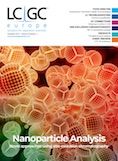Sizing Up Size-Exclusion Chromatography (Part 2)
LCGC Europe
In the second part of this interview on size-exclusion chromatography (SEC) André Striegel discusses the benefits of the technique to analyze nanoparticles and quantum dots, the complementary role of hydrodynamic chromatography (HDC), and the future of SEC in two-dimensional liquid chromatography (2D-LC) separations.
In the second part of this interview on size-exclusion chromatography (SEC) André Striegel discusses the benefits of the technique to analyze nanoparticles and quantum dots, the complementary role of hydrodynamic chromatography (HDC), and the future of SEC in two-dimensional liquid chromatography (2D-LC) separations.
Q. You developed an innovative method to analyze gold nanoparticles (NPs) that coupled inductively coupled plasma–mass spectrometry (ICPâMS) and quasiâelectric light scattering (QELS) to sizeâexclusion chromatography (SEC) as well as hydrodynamic chromatography (HDC) (1). What are the advantages of this approach in relation to SEC and HDC?
A: ICP-MS is an elemental-specific technique that can identify and quantitatively identify metals with high sensitivity. When coupled to a size-based separation method, such as SEC or HDC, this technique can also measure analyte column-recovery, to establish if a separation is quantitative or not. ICP-MS is therefore a massâselective detector and a mass-sensitive fraction detector. Adding QELS as a detection method provides a way to measure size, in this case the hydrodynamic radius, of the eluting fractions.
So we have an SEC technique that separates analytes according to their size in solution, coupled to QELS, a technique that measures size indirectly. What QELS actually measures is the translational diffusion coefficient of analytes in solution, which is related to hydrodynamic radius via the Stokes-Einstein relationship.
Coupled together, it is possible to measure the size heterogeneity of a sample by using QELS to measure the hydrodynamic radius (RH) continuously across the chromatogram, that is, by measuring RH at each SEC elution slice.
HDC provided a complementary alternative to SEC because, for some applications, there were no SEC columns available that did not leach particulate matter. These “leach fines” can scatter a tremendous amount of light and negate any advantages of using an on-line LS techniques, including QELS (1).
Q. Hydrodynamic chromatography is, perhaps, less familiar to separation scientists. Is this technique evolving and how is it used in practice?
A: In HDC, analytes sample the streamlines of flow in an open tube, or in the interstitial space of a column packed with solid, non-porous particles, in a size-dependent
manner. Larger analytes remain closer to the centre of the tube or interstitial space, where the faster streamlines reside.
Smaller analytes can approach the sides of the tube more closely than their larger counterparts, allowing the former to sample both the faster streamlines near the centre and the slower streamlines near the walls. Because of this, the average velocity of the smaller analytes is slower than that of the larger analytes, and the larger analytes elute earlier.
Elution order in HDC is identical to SEC, with larger analytes eluting ahead of smaller ones. The mechanism of retention is different, however: In SEC, retention is a result of the preferential sampling of particle pore volume, whereas in HDC retention is a result of the preferential sampling of the streamlines of flow.
HDC had been around for about three decades before we started working with this technique in the mid-2000s, as a result of the pioneering work of Hamish Small in the mid-1970s (2,3).The advantages of HDC are that it is a “gentle”, low shear technique, which makes it attractive for the analysis of fragile samples, and that it can couple with multiple detectors, specifically triple- and quadruple-detection. Employing multi-detector HDC in combination with separation science and polymer and colloid science principles can greatly enhance our understanding of the physicochemical properties of various particles, including nanoparticles, latexes, and ultrahigh molar mass polymers.
We discovered that for colloidal and polymeric samples that could not be accurately analyzed by SEC, even under optimal conditions, HDC could provide accurate molar mass and size data, and could do so in a relatively short time. I think these studies, most of which comprised the doctoral work of my former student Amandaa Brewer, helped to usher in the “modern era” of multi-detector HDC.
HDC definitely has certain limitations because it is chiefly performed using columns packed with large, non-porous particles and is therefore a lowâresolution chromatographic technique. HDC is fairly inexpensive to attempt if you already have an SEC system in place-pretty much all the hardware is identical and there are now more HDC columns commercially available.
The coupling of packed-column HDC to ICP-MS seems to have found a foothold in the environmental chemistry arena, while microcapillary HDC has already shown great promise as a bioanalytical technique. We have written a couple of reviews on the method (4,5), and I think readers will find novel applications popping up in the literature.
Q. You have also used SEC to analyze metal nanoparticles and quantum dots (1,6)? What was the rationale behind this research?
A: This project was partially motivated by the desire to quantitatively characterize the size distribution of gold nanoparticles and their blends.
Another motivator was to be able to measure the sizes of the various regions of quantum dots (QDs), including their total size as well as the sizes of the metal core and of the polymeric or oligomeric corona.
For the QD method, we combined SEC with on-line QELS detection to measure total size continuously across the elution profiles of CdSeS/ZnS QDs, and off-line transmission electron microscopy (TEM) to measure the size of the metallic core. The difference between these two sizes provided a very good approximation to the size of the corona.
Gold nanoparticles and quantum dots are widely used as sensors, for drug delivery, as light sources in imaging and displays, and even in home pregnancy tests. As such, metrological rigour is required when measuring their properties, including size and size distribution. Metrology is a main focus at NIST. My first postdoc here, Leena Pitkänen, did a critical survey of the literature over the past quarter century and found that, with less than a handful of exceptions, chromatographic recovery was never addressed in papers dealing with SEC for the analysis of NPs and QDs. When it was addressed it was usually in a qualitative fashion; for example, adding compound X to the mobile phase increased column recovery, without ever reporting to what value the recovery had been increased (7). So, a lot of what we focused on was on quantitating column recoveries and trying to maximize these values, and on addressing and optimizing the accuracy of our size determinations using hyphenated polymer chromatography techniques and related methods.
Q. Can you comment on the role of SEC in 2D-LC separations and where this technique is being used?
A: Most “real world” materials used in everyday applications-not model polymers synthesized and used strictly for academic research-are complex and possess distributions in a variety of parameters. For example, copolymers can possess distributions in both chemical composition and molar mass.
Other important parameters affecting polymer processing and end-use include long- and shortâchain branching, sequence length or “blockiness,” and polyelectrolytic charge. The distributions of many of these parameters can be determined using some type of interaction polymer liquid chromatography technique (IPLC), such as gradient polymer elution chromatography (GPEC) or liquid chromatography (LC) at critical conditions, as mentioned in Part 1 of this interview (8).
One constant, however, is that all synthetic polymers and even most (or, at least, the most abundant) natural polymers possess a distribution in molar mass. The latter makes SEC essential to most macromolecular 2D-LC methods. This is a two-way street, though, because SEC alone cannot provide a comprehensive characterization of these complex polymers, given that it separates based on analyte size (hydrodynamic volume), and chemical/structural differences may cause the coelution of different analytes because of the resultant coincidence in analyte size.
For a true understanding of what imparts polymers their desired properties, or when trying to discern their mode of failure, a multi-detector, multidimensional separations approach is needed. There are groups which have produced an abundance of elegant work in polymer 2D-LC (9).
For 2D-LC methods to evolve and become more widespread, we will need to develop a more fundamental understanding of both IPLC and of separation orthogonality. For IPLC, we currently lack a first-principles, non-empirical approach to method development.
The total peak capacity of multidimensional separations is directly related to the orthogonality of the methods themselves, as given by the separation angle between dimensions. Coupling together methods that are completely orthogonal to one another will result in a separation angle of 90º, a fairly self-evident result. Less self-evident is how to calculate the separation angle when coupling together methods that are only somewhat, perhaps even only slightly, orthogonal to one another. A few approaches to this have been proposed, including one by Wallace Yau, Jack Kirkland, Don Bly, and me. We put forth equation 14.2 in reference 10, which has its foundation in information theory and relies on the information theoretical concept of percent synentropy. This equation is applicable to all forms of multidimensional separations, not just polymer 2D-LC.
References
- L. Pitkänen, A.R. Montoro Bustos, K.E. Murphy, M.R. Winchester, and A.M. Striegel, J. Chromatogr. A 1511, 59–67 (2017).
- H. Small, J. Colloid and Interface Science48, 147–161 (1974).
- A.M. Striegel, LCGC Europe28(11), 606–611 (2015).
- A.M. Striegel and A.K. Brewer, Annu. Rev. Anal. Chem.5, 15–34 (2012).
- A.M. Striegel, Anal. Bioanal. Chem.402, 77–81 (2012).
- L. Pitkänen and A.M. Striegel, Anal. Bioanal. Chem.408, 4003–4010 (2016).
- L. Pitkänen and A.M. Striegel, TRAC80, 311–320 (2016).
- A. Matheson, LCGC Europe, 32(8), 420–423 (2019),
- H. Pasch and B. Trathnigg, Multidimensional HPLC of Polymers (Springer-Verlag, 2013).
- A.M. Striegel, W.W. Yau, J.J. Kirkland, and D.D. Bly, Modern Size-Exclusion Liquid Chromatography, 2nd edition (Wiley, 2009).

André Striegel is a research chemist in the Chemical Sciences Division of the Material Measurement Laboratory at the National Institute of Standards & Technology (NIST). He received his Ph.D. in analytical chemistry in 1996 and his B.S. in chemistry in 1991, both from the University of New Orleans (USA). From 1996 to 1998 he performed postdoctoral research for the U.S. Department of Agriculture, at the National Center for Agricultural Utilization Research. For the next six years he worked for Solutia (now Eastman Chemical), achieving the rank of Research Specialist. From 2004 to 2011 he was assistant professor of both analytical and materials chemistry in the Department of Chemistry and Biochemistry at Florida State University (FSU, USA). In September 2011 he joined NIST. His research interests are in the area of polymer characterization, in particular applying separation science to determining structureâproperty relations of complex macromolecules, and in the fundamental aspects of separation and detection methods.

Common Challenges in Nitrosamine Analysis: An LCGC International Peer Exchange
April 15th 2025A recent roundtable discussion featuring Aloka Srinivasan of Raaha, Mayank Bhanti of the United States Pharmacopeia (USP), and Amber Burch of Purisys discussed the challenges surrounding nitrosamine analysis in pharmaceuticals.
Silvia Radenkovic on Building Connections in the Scientific Community
April 11th 2025In the second part of our conversation with Silvia Radenkovic, she shares insights into her involvement in scientific organizations and offers advice for young scientists looking to engage more in scientific organizations.

.png&w=3840&q=75)

.png&w=3840&q=75)



.png&w=3840&q=75)



.png&w=3840&q=75)








